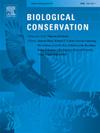管理人类与野生动物冲突的综合框架:阿根廷干查科美洲狮(美洲狮)掠夺小农牲畜的案例
IF 4.4
1区 环境科学与生态学
Q1 BIODIVERSITY CONSERVATION
引用次数: 0
摘要
野生动物对生计的负面影响,如牲畜被食肉动物掠夺,往往导致人类与野生动物的冲突,威胁野生动物种群和人类福祉。尽管数量越来越多,但很少有研究评估减轻此类影响的干预效果。我们提出了一个参与式框架,用于选择、实施和评估针对人类与野生动物冲突的干预措施。该项目应用于阿根廷干查科的一个社区,以减轻美洲狮(美洲狮)对牲畜的掠夺,并在该地区首次测试和部署了一种社区选择的干预措施:给小牲畜戴上镶有铆钉的皮项圈。拟议的框架从描述冲突的第一阶段开始,包括通过访谈对更广泛的社会生态背景进行区域评估,以及通过焦点小组讨论进行地方评估。然后,它包括管理冲突的三个可操作阶段。第2和第3阶段涉及通过基于有效性、可行性和成本的优先排序过程选择和测试潜在的干预措施。因此,他们选择了带钉的皮项圈,并通过随机对照试验对其进行了评估,结果显示,没有戴项圈的那一组的捕食率要高出10倍。在第4阶段,完全部署了干预措施,结果是试验期间观察到的掠夺率的一半。我们的研究证明了镶嵌皮革项圈在减少美洲狮袭击小型牲畜方面的有效性,并强调了将当地知识与基于证据的方法结合起来解决人类与野生动物冲突的价值。这一框架可以为有效的、对环境敏感的战略提供信息,并应用于减轻其他地方人类与野生动物相互作用产生的冲突。本文章由计算机程序翻译,如有差异,请以英文原文为准。
A comprehensive framework for managing human-wildlife conflicts: The case of smallholder livestock depredation by puma (Puma concolor) in the Argentine Dry Chaco
Negative impacts of wildlife on livelihoods, such as livestock depredation by carnivores, often lead to human-wildlife conflicts that threaten wildlife populations and human well-being. Despite a growing number, few studies have assessed intervention effectiveness to mitigate such impacts. We present a participatory framework for selecting, implementing, and evaluating interventions targeting human-wildlife conflicts. Applied to a community in the Argentine Dry Chaco to mitigate puma (Puma concolor) livestock depredation, it led to the first test and deployment of a community-selected intervention in the region: studded leather collars placed on small livestock. The proposed framework begins with a stage 1 for characterizing the conflict, consisting of a regional assessment of the broader social-ecological context through interviews, and a local assessment via focus group discussions. It then includes three actionable stages for managing the conflict. Stages 2 and 3 involve selecting and testing potential interventions through a prioritization process based on effectiveness, feasibility, and cost. This led to the selection of studded leather collars, which were evaluated through a randomized controlled trial showing that depredation was ten times higher in the uncollared group. In stage 4, the intervention is fully deployed, which resulted in half the depredation rate to that observed during the trial. Our study demonstrates the effectiveness of studded leather collars in reducing puma attacks on small livestock and highlights the value of integrating local knowledge with evidence-based approaches to address human-wildlife conflicts. This framework can inform effective, context-sensitive strategies and be applied to mitigate conflicts arising from human-wildlife interactions elsewhere.
求助全文
通过发布文献求助,成功后即可免费获取论文全文。
去求助
来源期刊

Biological Conservation
环境科学-环境科学
CiteScore
10.20
自引率
3.40%
发文量
295
审稿时长
61 days
期刊介绍:
Biological Conservation is an international leading journal in the discipline of conservation biology. The journal publishes articles spanning a diverse range of fields that contribute to the biological, sociological, and economic dimensions of conservation and natural resource management. The primary aim of Biological Conservation is the publication of high-quality papers that advance the science and practice of conservation, or which demonstrate the application of conservation principles for natural resource management and policy. Therefore it will be of interest to a broad international readership.
 求助内容:
求助内容: 应助结果提醒方式:
应助结果提醒方式:


